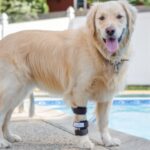Spaying is a surgical procedure that removes the ovaries and uterus of a female dog. It is also known as ovariohysterectomy or sterilization. Spaying has many benefits for your dog’s health and well-being, such as preventing unwanted pregnancies, reducing the risk of mammary tumors and uterine infections, and eliminating heat cycles and unwanted behaviors.
However, spaying is a major surgery that requires proper care and recovery. One of the most common problems that can occur after spaying and many pet owners worry about and use the statement my dog jumped after being spayed. Jumping can cause serious complications for your dog, such as tearing the stitches, opening the wound, bleeding, infection, or internal damage. Therefore, it is very important to keep your dog calm and restricted from jumping after spaying.
The main purpose of this article is to inform you about the dangers of jumping after spaying and how to prevent and deal with it. The thesis of this article is that jumping after spaying can have severe consequences for your dog, but you can help your dog recover faster and safer by following some simple tips and advice.
Why Did My Dog Jumped After Being Spayed How Long Should Dogs Be Kept Calm After Spaying
a dog jumped once or twice after being spayed and spaying is a major surgery that requires proper care and recovery. The general rule is to keep your dog calm and restricted from any strenuous activity for at least 10 to 14 days after spaying.
This means no running, jumping, playing, or climbing stairs. You should also avoid taking your dog for long walks or car rides, as these can cause motion sickness and nausea. The reason for this activity restriction is to prevent any damage to the incision site and internal tissues. Depending on the type of spaying, your dog may have different levels of sutures and closing methods.
Some dogs may have only one layer of sutures on the skin, while others may have two or three layers of sutures on the skin, muscle, and subcutaneous tissue. Some vets may use absorbable sutures that dissolve over time, while others may use non-absorbable sutures that need to be removed after 10 to 14 days.
Jumping can cause serious complications for your dog after spaying. Jumping can put pressure on the incision site and cause it to tear, bleed, or open up. This can lead to infection, inflammation, or herniation of the internal organs.
Jumping can also cause internal bleeding or hematoma, which is a collection of blood under the skin or in the abdomen. These complications can be life-threatening for your dog and require immediate veterinary attention. Therefore, it is very important to keep your dog calm and restricted from jumping after spaying.
What to do if your dog jumps after spaying and how to prevent it?
If your dog jumps after spaying, you should check the incision site for any signs of infection, bleeding, or opening. Some signs of infection are redness, swelling, pus, or foul odor. Some signs of bleeding or opening are blood stains, wetness, or gaps in the skin. If you notice any of these signs, you should call your vet or seek medical help immediately.
If a dog is too active after spaying to prevent your dog from jumping after spaying, you should use some tools and methods to limit your dog’s movement and jumping. One of the most common tools is a cone, also known as an Elizabethan collar or e-collar.
A cone is a plastic or fabric device that fits around your dog’s neck and prevents your dog from licking or biting the incision site. Another tool is a crate, which is a metal or plastic cage that provides a safe and comfortable space for your dog to rest and sleep.
A crate can also prevent your dog from running around or jumping on furniture. A third tool is a leash, which is a rope or chain that attaches to your dog’s collar or harness and allows you to control your dog’s movement and speed. A leash can also prevent your dog from chasing other animals or people. A fourth tool is a harness, which is a fabric or leather device that fits around your dog’s chest and back and distributes the pressure evenly. A harness can also prevent your dog from pulling or straining the incision site.
If your dog is injured and requires stitches but you can’t afford them how you manage this situation? read this article below
My dog needs stitches but I can’t afford it
How to help your dog recover faster and safer after spaying?
Spaying can cause some pain, discomfort, and grogginess for your dog after surgery. To help your dog cope with these symptoms, you should follow some tips and advice. First, you should give your dog the prescribed pain medication and antibiotics as directed by your vet.
This can help your dog feel more comfortable and prevent infection. Second, you should provide your dog with a soft and warm bed, fresh water, and bland food. This can help your dog rest and hydrate better. and make sure your dog avoids jumping on the bed after being spayed Third, you should avoid bathing or grooming your dog until the incision site is fully healed. This can prevent irritation and infection.
Following the vet’s instructions and monitoring your dog’s progress are important for your dog’s recovery. You should check the incision site daily for any signs of infection, bleeding, or opening. You should also keep track of your dog’s appetite, temperature, and behavior. If you notice any changes or problems, you should contact your vet immediately.
Keeping your dog entertained and stimulated after spaying can be challenging, but not impossible. You can try some low-impact activities and games that do not involve jumping or running.
For example, you can play hide and seek with your dog by hiding treats or toys around the house. You can also teach your dog some new tricks or commands using positive reinforcement. You can also give your dog some puzzle toys or chew toys that can keep your dog busy and satisfied. By following these tips and advice, you can help your dog recover faster and safer after spaying.
What are some common side effects of spaying?
Spaying is a surgical procedure that removes the ovaries and uterus of a female dog. It has many benefits for your dog’s health and well-being, but it also has some possible side effects and risks if your dog jumps after being neutered. Some of the common side effects of spaying are:
- Pain and discomfort: Your dog may feel some pain and discomfort after the surgery, especially around the incision site. Sometimes a dog jumps after being spayed for pain, you should give your dog the prescribed pain medication and antibiotics as directed by your vet. You should also provide your dog with a soft and warm bed, fresh water, and bland food.
- Infection and bleeding: Your dog may develop an infection or bleeding at the incision site if the sutures are torn, opened, or infected. You should check the incision site daily for any signs of redness, swelling, pus, blood, or gaps. You should also prevent your dog from licking, biting, or scratching the wound. If you notice any problems, you should call your vet or seek medical help immediately.
- Incontinence and urinary tract infections: Your dog may have difficulty controlling her urine or develop urinary tract infections after spaying. This is because spaying reduces the estrogen hormone levels in your dog, which affects the sphincter muscle that controls the bladder. This is more common in large breeds and overweight dogs. You can treat this condition with medication or supplements prescribed by your vet.
- Weight gain and obesity: Your dog may gain weight or become obese after spaying. This is because spaying slows down your dog’s metabolism and may increase her appetite. You should monitor your dog’s food intake and weight regularly and adjust her diet accordingly. You should also provide your dog with some low-impact exercise and activity to keep her fit and healthy.
- Hypothyroidism: Your dog may develop hypothyroidism after spaying. This is a condition where your dog’s thyroid gland does not produce enough thyroid hormones, which regulate the body’s metabolism and energy levels. Symptoms of hypothyroidism include lethargy, hair loss, dry skin, cold intolerance, and weight gain. You can diagnose this condition with a blood test and treat it with medication prescribed by your vet.
- These are some of the common side effects of spaying a dog. However, they are not very frequent or severe, and they can be easily prevented or treated with proper care and attention.
Spaying has many benefits for your dog’s health and well-being, such as preventing unwanted pregnancies, reducing the risk of mammary tumors and uterine infections, and eliminating heat cycles and unwanted behaviors. Therefore, spaying is generally recommended for most female dogs unless there are specific medical reasons not to do so. If you have any questions or concerns about spaying your dog, you should consult your vet for more information and advice.
What is the Best Age to Spay a Dog?
Spaying is a surgical procedure that removes the ovaries and uterus of a female dog, which can prevent unwanted pregnancies, reduce the risk of mammary tumors and uterine infections, and eliminate heat cycles and unwanted behaviors.
However, spaying also has some possible side effects and risks, such as joint disorders and cancers, which may vary depending on the size, breed, and sex of the dog. Therefore, the best age to spay a dog should be based on an informed, case-by-case assessment of each dog, taking into account all the potential risks and benefits of spaying.
You should consult your vet for more information and advice on when to spay your dog. You can also check out these tables that provide spay/neuter recommendations for 33 different dog breeds and mixed breed dogs based on their weight categories.What are some other activities that my dog should avoid after spaying?
Spaying is a surgical procedure that removes the ovaries and uterus of a female dog. It has many benefits for your dog’s health and well-being, but it also requires proper care Besides stairs, there are some other activities that your dog should avoid after spaying, such as:
Running, jumping, and excessive playing: These activities can increase your dog’s risk of developing swelling, bleeding, or infection around the incision site. They can also cause the sutures to tear or open, leading to internal damage.
Bathing, swimming, or playing in deep snow: These activities can make the incision wet, which can delay the healing process and increase the chance of infection. You should keep the incision dry until it is fully healed.
Licking, biting, or scratching the incision: These behaviors can irritate the wound and cause it to open or become infected. You should use a cone, crate, leash, or harness to prevent your dog from reaching the incision with their mouth or paws.
Chasing other animals or people: This activity can cause your dog to pull or strain the incision site, which can result in bleeding or herniation of the internal organs. You should keep your dog on a leash away from other animals or people until they fully recover.
You should keep your dog calm and restricted from these activities for at least 10 to 14 days after spaying. You should also follow your vet’s instructions and monitor your dog’s progress closely. If you notice any signs of complications, such as redness, swelling, pus, blood, or gaps in the incision site, you should call your vet or seek medical help immediately.
Can I bathe my dog after spaying surgery?
Spaying is a surgical procedure that removes the ovaries and uterus of a female dog. It has many benefits for your dog’s health and well-being, but it also requires proper care and recovery.
- Most vets recommend that you don’t bathe your dog for 10 to 14 days after spay surgery (or neutering surgery). This also includes getting any water on your dog’s wounds when swimming, paddling, or even rainwater.
- This is because bathing your dog can make the incision wet, which can delay the healing process and increase the chance of infection. It can also cause the sutures to tear or open, leading to internal damage.
- You should keep the incision dry until it is fully healed. You should also prevent your dog from licking, biting, or scratching the wound. You can use a cone, crate, leash, or harness to limit your dog’s movement and jumping.
- If you need to clean your dog, you can use some special products like waterless shampoo or pet wipes to keep your furry pal clean and smelling fresh. You can also gently clean the area around the incision with a cotton ball and water, but avoid getting the sutures wet.
Conclusion
My dog jumped after being spayed and how harmful it will be for a dog’s health. Spaying is a surgical procedure that removes the ovaries and uterus of a female dog. It has many benefits
for your dog’s health and well-being, such as preventing unwanted pregnancies, reducing the risk of mammary tumors and uterine infections, and eliminating heat cycles and unwanted behaviors. However, spaying also has some possible side effects and risks, such as joint disorders and cancers.
These risks may vary depending on the size, breed, and sex of the dog. The best age to spay a dog should be based on an informed, case-by-case assessment of each dog, taking into account all the potential risks and benefits of spaying. You should consult your vet for more information and advice on when to spay your dog. You can also check out these tables that provide spay/neuter recommendations for 33 different dog breeds and mixed breed dogs based on their weight categories.
Spaying is a responsible and beneficial decision for most female dogs unless there are specific medical reasons not to do so. By spaying your dog, you can improve your dog’s health and well-being, as well as reduce the number of unwanted dogs in shelters and streets.
FAQs About My Dog Jumped After Being Spayed
Q. How long should dogs take it easy after spaying, and why did my dog My Dog Jumped After Being Spayed
Answer: It’s advised to keep your dog calm for about 10 to 14 days post-spaying. Jumping can lead to complications like torn stitches or internal damage, emphasizing the importance of a calm recovery period.
Q. If my dog jumps after spaying, what steps can I take to prevent it, and what should I do if it happens?
Answer: To prevent jumping, consider tools like a cone, crate, leash, or harness. If jumping occurs, check for signs of infection or bleeding. Swift action, like contacting your vet, ensures your dog’s safety and a smoother recovery.
Q. How can I support my dog’s faster and safer recovery after spaying?
Answer: Administer prescribed pain medication, create a comfortable resting space, and refrain from bathing until the incision site is fully healed. Follow your vet’s instructions, monitor for complications, and engage in low-impact activities for a speedier and safer recuperation.
Q. What are some potential side effects of spaying, and how can pet owners address them?
Answer: Common side effects include pain, infection, bleeding, incontinence, weight gain, and hypothyroidism. These issues can be managed through proper care, prescribed medications, and regular check-ups. Consult with your vet for personalized guidance.
Q. Can I bathe my dog after spaying, and why is it recommended to wait initially?
Answer: Most vets suggest avoiding baths for 10 to 14 days post-spaying to prevent the incision site from getting wet, which could delay healing and increase infection risks. Opt for alternatives like waterless shampoo or pet wipes to maintain cleanliness during this recovery phase.
My Dog Jumped After Being Spayed, What Should I Do?







